This is fun!
I think through twelve years and 2,500 blog posts, I’ve actually never written about this before.
We’ve probably talked about it indirectly, but in terms of the actual level of homogeneity that exists on a street, today’s blog will be a first.
Now for those not aware, the definition as we recall from Grade-9 science:
ho-mo-ge-ne-ous
/ˌhōməˈjēnēəs/
adjective
Of the same kind; alike
“Timbermen prefer to deal with homogenous woods.”
Synonyms: similar, comparable, equivalent, like, analogous, corresponding, matching, kindred, related
Okay, so they look the same. You got it. No explanation needed.
Now if you’re like me, your biggest fear actually IS being the same, ie. as another person. I’ve never really wanted to “fit the mould,” and while I’m not exactly an outsider, I never aspired to conformity either.
But what about when it comes to your neighbourhood? And your house?
Do you want to live in an area where the houses look similar? Do you want them to look completely different?
Do you even care?
Very rarely will a new buyer-client describe their dream home and say, “I want a very homogeneous streetscape,” but it does happen from time to time.
What happens more often, however, is that once we’re out looking at houses, the buyer might say, “I don’t like the look and feel of this block as much as the last one.” So while the buyer might not use the word “homogenous” and might not even detail that he or she feels this block doesn’t have the feeling of similarity, the buyer looks back at the last block, and compares.
And that’s really when the concept of homogeneity is most apparent.
You don’t really know, or realize, how homogenous a street is until you’ve compared it to another one.
And for many buyers, this doesn’t even dawn on them until they’re out looking at houses.
Once upon a time, the neighbourhood that everybody wanted to live in looked something like this:
Yes, that is literally “Pleasantville.” As in, from the movie.
The only thing missing is a father coming home at 5:01pm, from the same job he’s had his whole life, to meet his two kids – one boy and one girl, and kissing his wife, who’s wearing a long, flowery dress, and who is waiting for the pot-roast in the oven.
Yeah, well, it’s 2019.
Even then, to be quite honest, those houses are far from identical. And I think the difficult point I’m trying to make is that while many buyers desire a homogenous streetscape, they also don’t want houses to look identical.
Think about something like this:
That photo above accurately portrays the house that many of you live in.
But it’s almost unavoidable in many areas of the city.
Most areas north of Toronto, ie. Markham, Stouffville, Woodbridge, Kleinberg, et al, are built exactly like this.
And while I hesitate to use the term “sub-division,” because it has such a negative connotation, I think virtually every neighbourhood in the GTA started, at one point or another, as a sub-division.
So while I’m not trying exclude those of you who live in the areas described above, recognizing that many neighbourhoods are built to look the same, I wanted to talk more about the streetscapes as they pertain to the central core.
Because here is where the homogeneity is valuable to some, and not to others.
My office is on Merton Street, so I figured I’d take a look at two areas nearby: Leaside, and Davisville Village.
Leaside is known for having the “tree-canopied streets” like you might find in The Kingsway or other notable Toronto negibhourhoods, and it’s romanticized to a level that some support, and others ignore. It’s also known for having a very homogenous streetscape, since the entire area was, believe it or not, built as a sub-division in the 1940’s.
Here’s a look at a row of semi-detached houses on Vanderhoof Avenue:
Note that there are eight houses pictured, and all eight look similar, if not the same.
All are semi-detached, all have the same widened-mutual driveway, and all are red-brick.
The first four houses all have the identical moulding above the front door.
So are these houses similar? Or are they too similar?
Do you see any difference here between this streetscape, and the proverbial “sub-division” pictured above?
And do you care? That’s the burning question I have today, because I honestly think that half of you, at least, will not care about streetscape.
So maybe those semi-detached houses are too similar.
Here’s a shot of detached houses on Fleming Crescent in South Leaside:
So there’s some variety here.
These are all detached houses, likely on identical 30-foot lots, all with private driveways.
But they’re not identical. Different colour bricks, different roof shapes, different landscaping – there’s more variety here than with the semi-detached houses.
So is this something you covet?
Maybe you don’t even know.
Which is why, as I alluded to at the start, most buyers need a comparison.
Consider the detached house here on Hillsdale Avenue in Davisville Village:
On the left of this detached house, we have three “rowhouses,” although I would argue only the one in the middle is a rownhouse, and the other two are semi-detached. But you get the idea – it’s a block of three houses attached. On the right of this detached house, we have two semi’s (the second not quite pictured – it’s too horizontal a photo).
So does this streetscape look “worse” than the one in Leaside?
Again, do you care?
Maybe this house is better/worse than the others, but I’m trying to decipher whether or not you, the would-be buyer, puts a value on homogeneity.
Now what if our detached house wasn’t in between rowhouses and semi’s?
What if it was in between something else?
Look at this house, also in Davisville Village:
On the left of this detached house are two semi-detached multi-unit dwellings.
And this is very common in Davisville Village, where you have a variety of housing types and styles.
You might find a detached house next to a purpose-built triplex, whereas you wouldn’t find that on the east side of Bayview.
So do you value this detached house any less than the ones above, all things considered equal?
And here’s where the concept of “value” gets interesting, because if the subject property were identical in all of these cases, then we would be assessing value based on other houses around it.
Let’s look at one more:
Here we have, starting from the left, two semi-detached houses that look like that 1970’s/1980’s era, then a purpose-built triplex that’s ugly as hell, then an A-frame detached, then a 1 1/2 storey, then what looks like an A-frame bungalow but also might be a 1-1/2 storey.
How do you feel about this streetscape?
For those of you who were leaning toward the “I really dont’ care about homogeneity” side of the argument, do you still feel the same way?
Can you tell me, in all honesty, that if you picked up your dream home and put it down in the middle of this block that you wouldn’t care what surrounds it?
As you can tell from my tone, I believe there is a value to the streetscape, and I do believe that some level of homogeneity creates value.
How much value is the question.
Anybody have the answer?


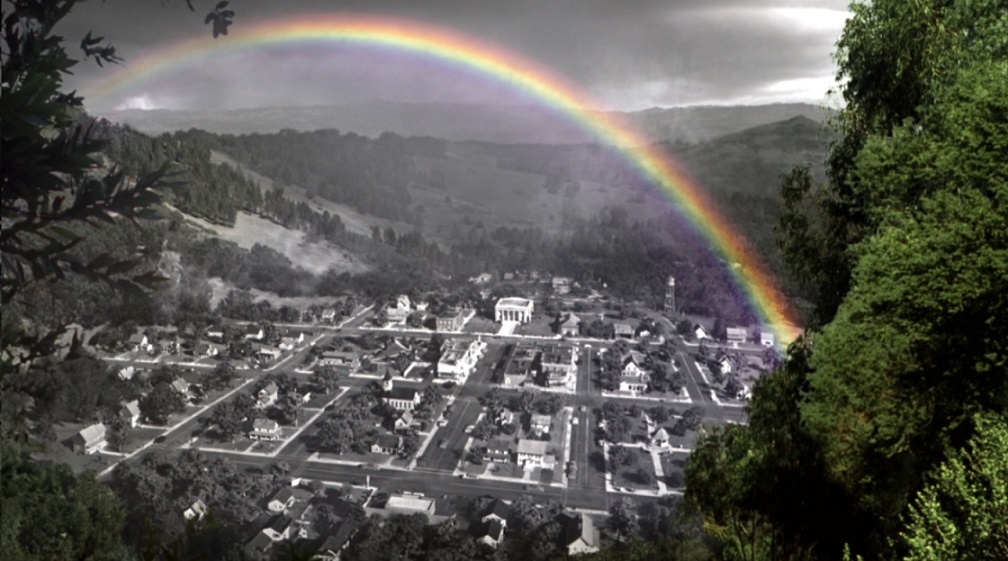
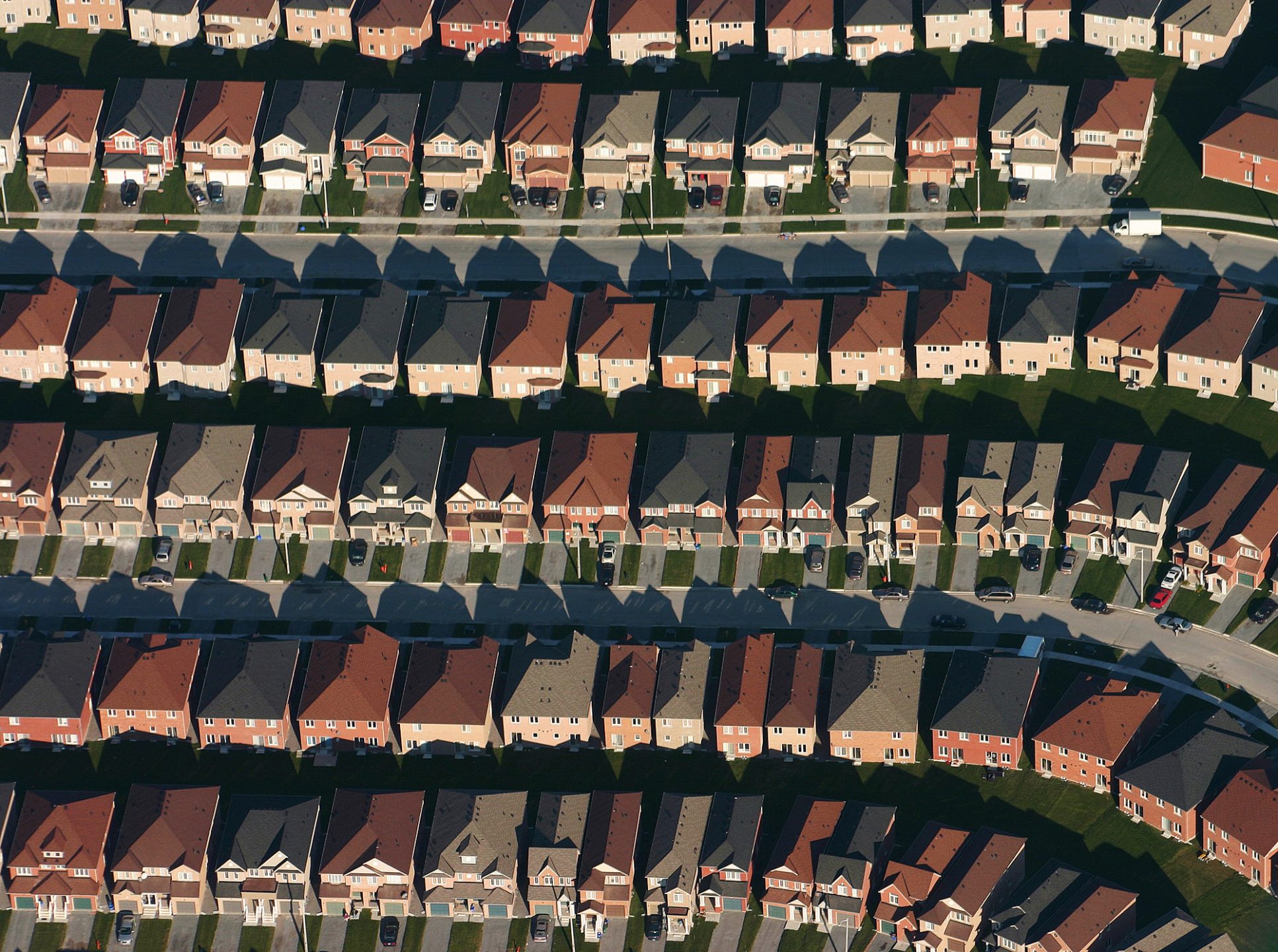
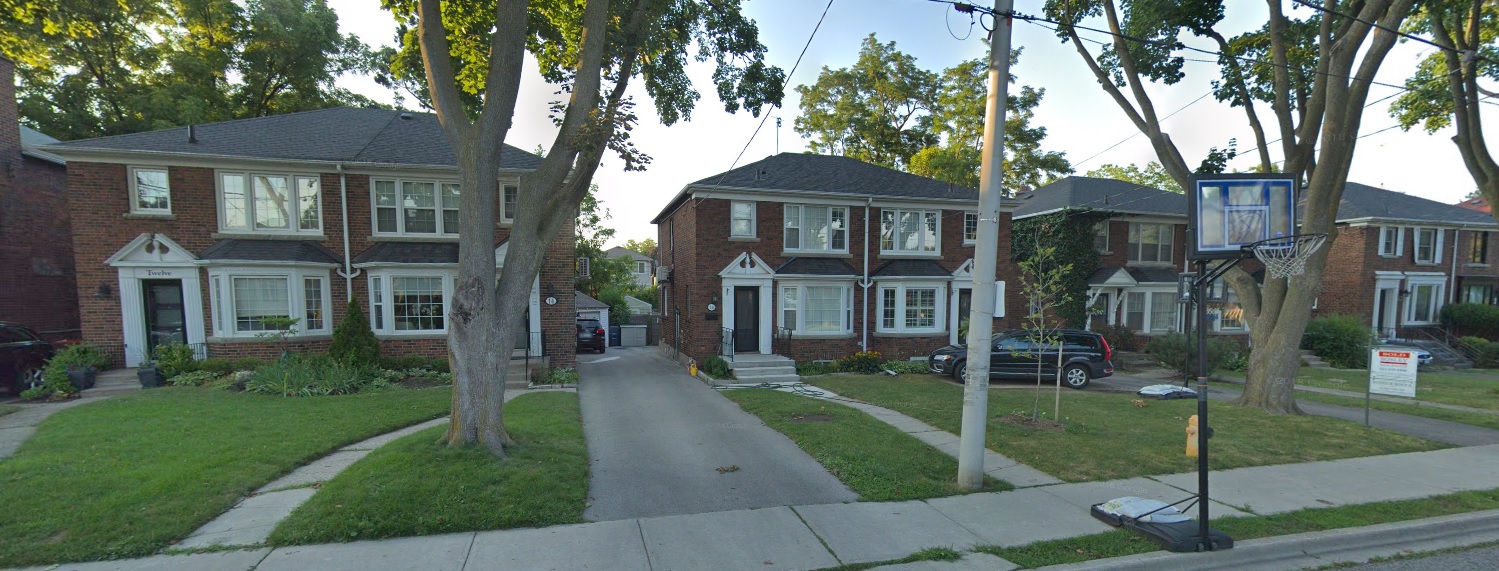
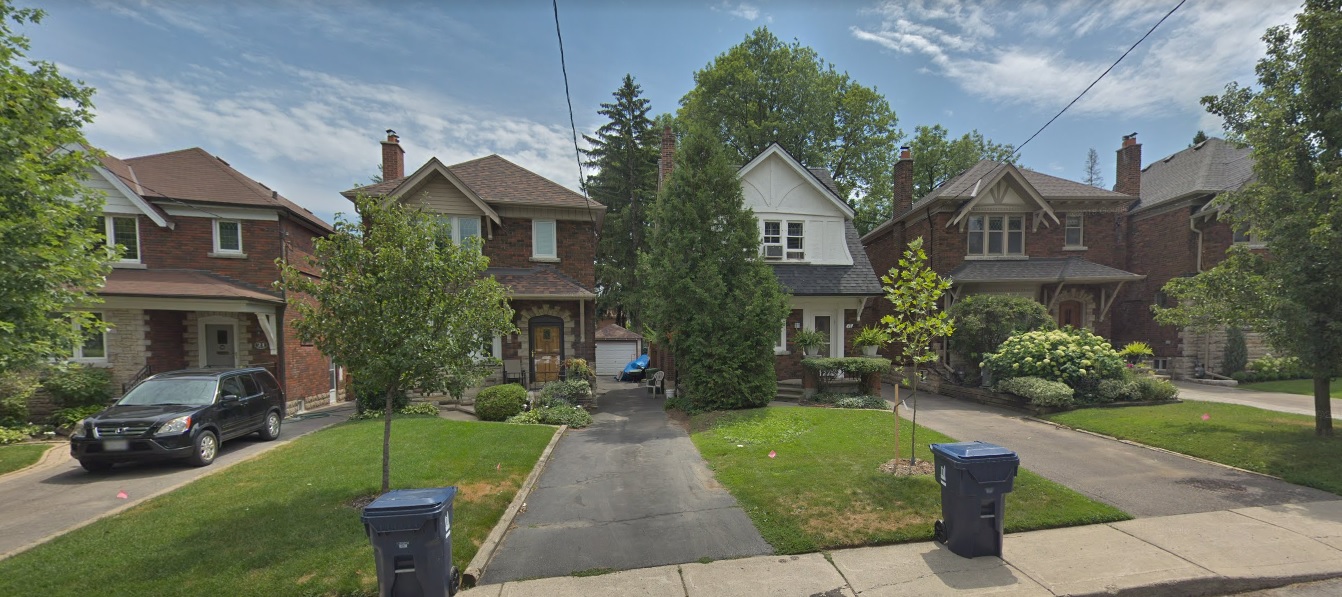
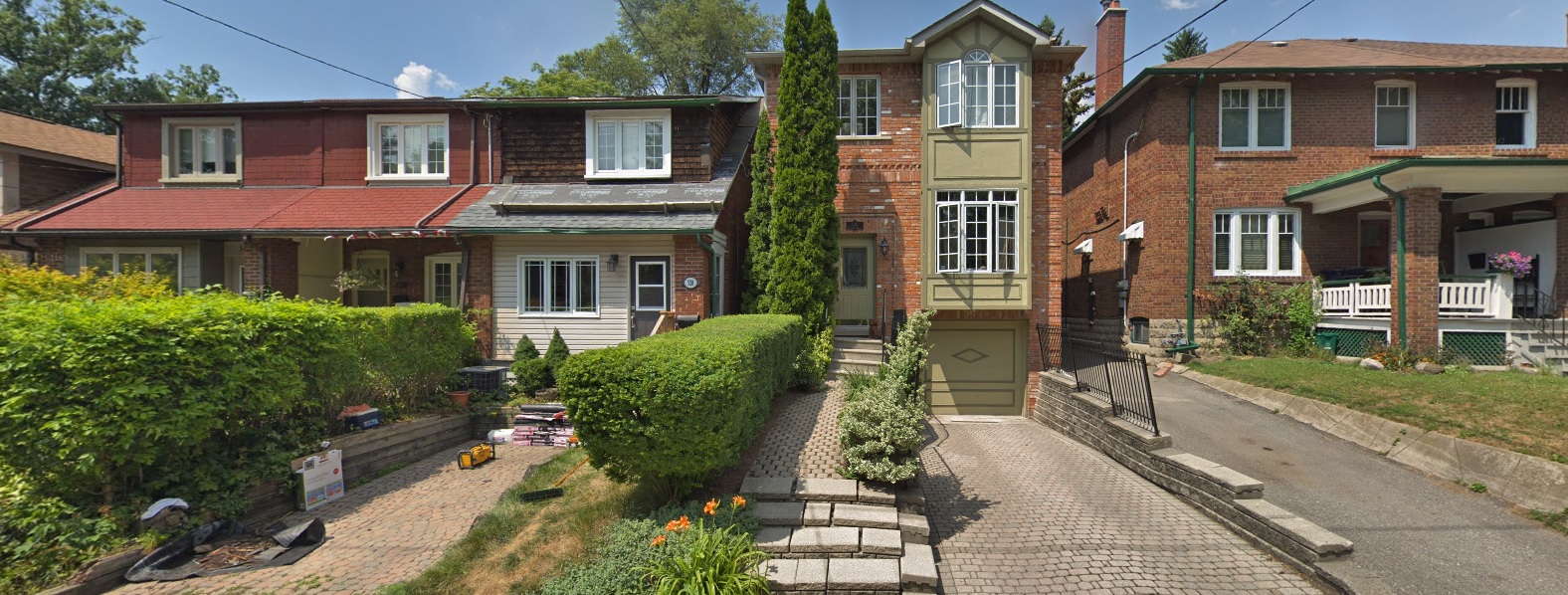






























Appraiser
at 6:37 am
TREB April sales data is out this morning.
Overall sales up 16.8% and average prices ahead 1.9% year over year.
Condo apartment average prices are up 5.1% year over year.
Chris
at 11:30 am
Stronger April than I would have expected at the beginning of the year.
Sales are still well below most Aprils in recent memory, but +17% YoY is nothing to sneeze at. Price +1.9% is on par with inflation.
Hard to see OSFI removing/adjusting B20 in the face of these results though.
Appraiser
at 3:20 pm
Benchmark prices are up 3.2% – soundly defeating inflation. Rents for 1 one-bedroom apartments are up 7.3% year over year.
Lots of good reasons to de-stess the stress test.
Chris
at 3:30 pm
Looks like CMHC and BoC disagree with you.
https://twitter.com/ewsiddall/status/1124441064205692928
And today:
Poloz also continued to champion tougher mortgage qualification rules that have recently come under attack by the real estate industry. He said that to the extent these new measures have curbed demand, they’ve also made the financial system more resilient and helped reduce speculative behaviour.
“‘Evidence suggests that the new guidelines have been working as designed,” Poloz said.
Appraiser
at 6:41 pm
Unfortunately, it’s the unintended consequences of the stress test that are not “working as designed.”
Haven’t seen one bear yet dare to question the brilliance and infallibility of the new rule, or any possible amendments thereto…hmmm.
Chris
at 6:58 pm
That is your opinion, not fact. You and some others, like TREB and TD, may feel the stress test is not working. You’re entitled to your view.
Clearly, however, the CMHC, BoC, Dept. of Finance, and OSFI feel the test is appropriate and thus do not see the need to remove or amend it at this time.
Given its backers, I would be surprised if B20 disappears anytime soon, unless conditions change dramatically.
Derek
at 8:24 pm
What outcomes would you want to see with stress test tweaks?
Appraiser
at 9:59 am
It’s time to admit that their are some flies in the ointment. It is becoming painfully obvious that the test is imperfect , perhaps an honest case of regulatory overreach.
I see no reason why the test can’t immediately be reduced to either 1% or 1.5%, from the currently punitive 2%. The rate could then be closely monitored and set on a regular basis, much like the bank of Canada overnight rate.
Chris
at 10:58 am
From mid-2017 to late-2018, the Bank of Canada raised their benchmark interest rate five times, for a cumulative gain of 1.25%.
How does a stress test at +1%, less than the actual ~18 month increase in the benchmark rate, make sense? Isn’t the point of this stress test to examine the impact of a plausible strain on a household finances? A 2% increase in interest rates over a mortgage’s term does not seem like an outlandish possibility.
I think what would be reasonable would be to consider principal pay down over the mortgage term, and how this impacts debt service ratio in the face of increased interest rates.
Simply reducing the qualifying rate doesn’t seem to make much sense.
Housing Bear
at 9:53 am
Yeah relatively strong month. Good sales growth overall. Average prices being up is a combo of the strength in the condo sector plus a changing sales mix with a higher weighting of detached sales. I still say the market cannot break until we seen a swing in 1 bdr condos. Market floor, and as long as they are doing well their will be liquidity for move up buyers which puts on floor on how far everything else can fall. This is exactly how it played out in Vancouver. Detached and luxury has been falling for over 2 years, but market at as a whole didn’t go sideways until condos started to plunge. We have started to show a lot more weakness in new condo sales but resale is holding up well enough.
That being said, our bet for July is based on TREB average, its looking like you will win this one.
For stress test, I have said before that I do not think it should apply to renewals, that only allows the big banks to squeeze a bit more money out of their customers in my opinion. For new sales I think it is still prudent to keep it. Unless in very extreme situations, BOC follows the FED (like to maintain a stable Canadian dollar), US economy has been posting solid numbers and their could be more rate hikes down there.
Derek
at 10:28 am
Appraiser, what are the points that make it “painfully obvious” the test is flawed? I just mean that insofar as OSFI has a mandate, the outcome seems to be as it desired. I don’t think OSFI cares about rents, for example.
Dave
at 8:44 am
I guess all blog posts can’t be home runs…
Jenn
at 9:29 am
No I rather likes this post! Definitely something new and different.
Personally I feel a streetscape is part and parcel of “curb appeal.” I think nobody wants to own the nicest house on the street, and you would like to think that your neighbours are taking as much pride in their homes’ appearance as you are.
Not to judge, but photo of the last streetscape that you showed it made everything look rather run down. I’m sure that these are multi million dollar homes because they are in Toronto, but I definitely notice a big difference!
Derek
at 10:30 am
I like this post too and I think it is a “real” phenomenon. Two streets south of my street, a bunch of homes have been and are being turned over into those modern boxy houses. My wife has refused to ever look at them because she doesn’t like the “feel” of the street and I think a main factor is the mixture of housing types on that street (2-storey / 1 1/2 storey/detached/semi/bungalow), whearas our street is pretty uniform in 2 storey detached. Another “feel” factor that is palpable is the width of the street and the parking rules. Our street at least feels wider than the second street. Also, some streets in our area permit parking on both sides whereas our street is one sided parking. The former can “feel” too claustrophobic and “busy”. Of course, if we had not lived on our street for 8 years, you might not notice those subtle differences and be less picky and have moved already lol.
Derek
at 4:51 pm
I also wonder if there is a mathematical graph that explains the relationship between the “feel” of a street and the set-back distance of the houses from the street.
Condodweller
at 11:05 am
I agree streets with long driveways feel nicer however the question is what are you giving up for that feel? If the houses are simply shifted further back on the same lot size I’d rather have the back yard space instead of the good feel as I drive up to my house. If the back yard is already a good size perhaps it’s not a big deal to have a 50-foot driveway but I think I’m always going to think it would be nice to have some of that pace in the back instead.
jeff316
at 3:46 pm
Fixed-up homogenous streetscape > fixed-up varied streetscape > streetscape in various states of repair
jeff316
at 3:59 pm
I also think it is preferable to have not-quite-consistent infill (like in the third photo, where the newer house doesn’t match but is brick and relatively benign-looking) vs some way-out, modern design in the midst of a bunch of houses from the 1930s.
Moonbeam!
at 6:49 pm
Geez..
Moonbeam!
at 6:56 pm
Meant to ‘Dave’
Condodweller
at 11:14 am
This is an interesting topic and I do wonder how values are impacted by “unwanted” houses nearby. Different style houses I wouldn’t think should affect values as much as different use houses would. I.e. a 4 unit multiplex rental next door I would expect to lower the value of a house next door. Aside from the looks, it generates more traffic and some people might not want lowly renters living next door to their million+ home.
I wouldn’t have an issue with a fresh new design “box” next door as I think it might add value. I would much rather have a new well maintained but different style home next door than a rundown, tired old house of the same type.
I’m interested in the conclusions in the follow-up post.
Kyle
at 11:41 am
I 100% agree there is value to a nicer streetscape. But IMO, what defines a nice streetscape has more to do with a “feel” you have when you’re on the street than it has to do with the homogeneity of the homes.
Sure, some homogeneity of homes can look good (e.g. Cabbagetown’s Victorians, Bloor West Village’s 4 squares), but what contributes more to the “feel” are often things like tree canopy, how well-kept the properties are, lack of fences between the houses, an overall sense of quality and good architecture to the homes. And it certainly doesn’t hurt if the community was master planned (e.g. Rosedale, The Kingsway, Wychwood Park, etc).
IMO, some of the best streetscapes have little to no homogeneity but lots of the stuff mentioned above. For example Rosedale, Playter Estates, Palmerston Blvd, The Kingsway, Baby Point, and Wychwood Park. All the homes are completely non-homogenous and often vary in lot width and size.